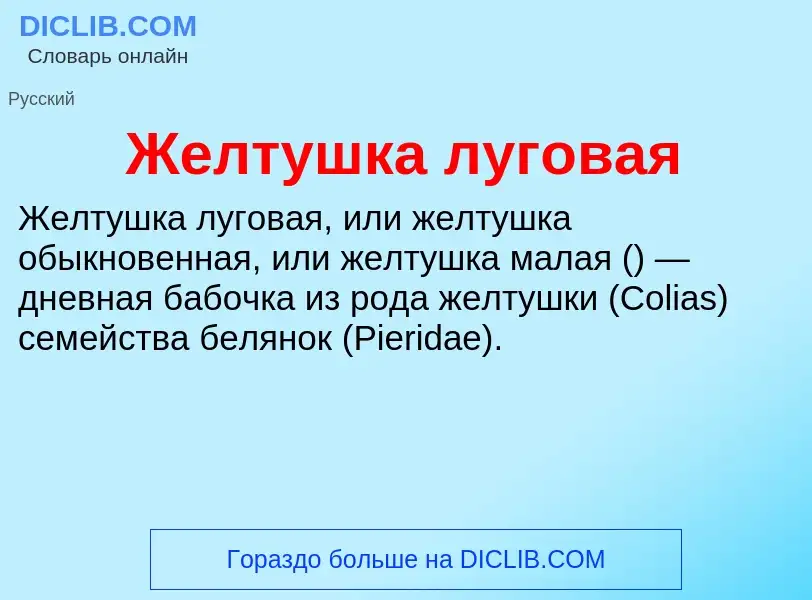Enter a word or phrase in any language 👆
Language:
Translation and analysis of words by artificial intelligence
On this page you can get a detailed analysis of a word or phrase, produced by the best artificial intelligence technology to date:
- how the word is used
- frequency of use
- it is used more often in oral or written speech
- word translation options
- usage examples (several phrases with translation)
- etymology
What (who) is желтушка - definition
Желтушка луговая
ВИД НАСЕКОМЫХ
Colias hyale
Желтушка луговая, или желтушка обыкновенная, или желтушка малая () — дневная бабочка из рода желтушки (Colias) семейства белянок (Pieridae).
Желтушки
РОД НАСЕКОМЫХ
Желтянки; Colias
(Colias)
род дневных бабочек семейства белянок. Крылья в размахе до 6 см, красной, оранжевой, жёлтой, зеленоватой окраски; на наружной стороне крыльев часто имеется чёрный ободок. У Ж. выражен половой диморфизм или полиморфизм: крылья у самок окрашены бледнее, чем у самцов (обычно зеленоватые или белые); у некоторых видов Ж. самки двух типов, например у большой авроры (Colias aurora) - красные и зелёные. Распространены Ж. в Северном полушарии; обитают главным образом в высокогорьях и в арктической зоне. Лишь немногие Ж. встречаются на равнинах: Colias palaeno типичен для болот лесной зоны Европы и Азии, С. hyale, С. erate и С. chrysotheme - для степной зоны. Некоторые Ж. - второстепенные вредители сельского хозяйства; например, малая (С. hyale) и люцерновая (С. erate) Ж. вредят в Средней Азии люцерне, гороху, клеверу.
Желтушка торфяниковая
Желтушка торфяниковая, или желтушка торфяная () — дневная бабочка из семейства желтушки (Colias). Видовой эпитет происходит от Палэно — в древнегреческой мифологии водная нимфа.
Examples of use of желтушка
1. В местной больнице (мы живём в Нижневартовске) поставили диагноз "физиологическая желтушка" , однако лечение результатов не давало.
2. Все было хорошо, только желтушка не проходила, - вспоминает отец девочки, Александр Кривошеев.


 Colias hyale - Novy Jicin Moravie Czech Republic - male dorsal.jpg ?width=200)
 Colias hyale - Novy Jicin Moravie Czech Republic - male ventral.jpg?width=200)
 Colias hyale - Novy Jicin Moravie Czech Republic - female dorsal.jpg?width=200)
 Colias hyale - Novy Jicin Moravie Czech Republic - female ventral.jpg?width=200)

 Colias hyale - Novy Jicin Moravie Czech Republic - male dorsal.jpg?width=200)
![Colias aurorina heldreichi]]'', ♂ Colias aurorina heldreichi]]'', ♂](https://commons.wikimedia.org/wiki/Special:FilePath/Colias.aurorina.heldreichi.mounted.jpg?width=200)
 Colias christophi - Tadjikistan Russie - male.jpg ?width=200)
![''[[Colias myrmidone]]'', ♂ ''[[Colias myrmidone]]'', ♂](https://commons.wikimedia.org/wiki/Special:FilePath/(MHNT) Colias myrmidone myrmidone - Stará Turá Slovaquie - male.jpg?width=200)
![''[[Colias eurytheme]]'', ♂ ''[[Colias eurytheme]]'', ♂](https://commons.wikimedia.org/wiki/Special:FilePath/Male Orange Sulphur Megan McCarty18.jpg?width=200)
![''[[Colias croceus]]'', ♂ ''[[Colias croceus]]'', ♂](https://commons.wikimedia.org/wiki/Special:FilePath/(MHNT) Colias croceus - Durfort Tarn France - male.jpg ?width=200)
![''[[Colias croceus]]'', ♂ ''f.helice'' ''[[Colias croceus]]'', ♂ ''f.helice''](https://commons.wikimedia.org/wiki/Special:FilePath/(MHNT) Colias croceus f. helice - Wyzyna, Okolice Polska - male.jpg?width=200)
![''[[Colias chrysotheme]]'' ♂ ''[[Colias chrysotheme]]'' ♂](https://commons.wikimedia.org/wiki/Special:FilePath/(MHNT) Colias chrysotheme chrysotheme - Érd Hongrie - male.jpg?width=200)
![''[[Colias philodice]]'' ♀ ''[[Colias philodice]]'' ♀](https://commons.wikimedia.org/wiki/Special:FilePath/Female Clouded Sulphur Megan McCarty42.jpg?width=200)
![''[[Colias philodice]]'' ♀ ''f.alba'' ''[[Colias philodice]]'' ♀ ''f.alba''](https://commons.wikimedia.org/wiki/Special:FilePath/Colias philodice white form.jpg?width=200)
![''[[Colias philodice]]'', ♂ ''[[Colias philodice]]'', ♂](https://commons.wikimedia.org/wiki/Special:FilePath/Male Clouded Sulphur Megan McCarty40.jpg?width=200)
![''[[Colias alfacariensis]]'', ♂ ''[[Colias alfacariensis]]'', ♂](https://commons.wikimedia.org/wiki/Special:FilePath/Colias alfacariensis.jpg?width=200)
![''[[Colias palaeno]]'', ♂ ''[[Colias palaeno]]'', ♂](https://commons.wikimedia.org/wiki/Special:FilePath/(MHNT) Colias palaeno - Majdan Kasztelański Pologne - male dorsal.jpg?width=200)
![''[[Colias palaeno]]'', ♀ ''[[Colias palaeno]]'', ♀](https://commons.wikimedia.org/wiki/Special:FilePath/Colias palaeno.female.jpg?width=200)
![''[[Colias phicomone]]'', ♂ ''[[Colias phicomone]]'', ♂](https://commons.wikimedia.org/wiki/Special:FilePath/(MHNT) Colias Phicomone - Pic d'Aneto Espagne - male.jpg ?width=200)
![''[[Colias romanovi]]'', ♂ ''[[Colias romanovi]]'', ♂](https://commons.wikimedia.org/wiki/Special:FilePath/Colias romanovi m.jpg?width=200)
